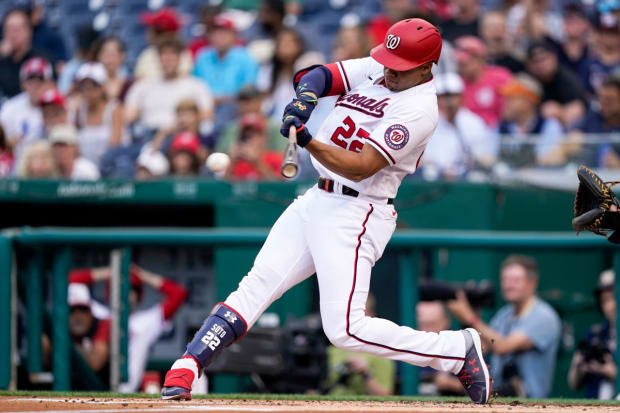Welcome to The Opener, where every weekday morning during the regular season you’ll get a fresh, topical story to start your day from one of SI.com’s MLB writers.
Of all the options the Nationals face with Juan Soto, the least likely is signing him to a contract extension, even one for more money than has ever been guaranteed a player. They know this, which is why they changed his trade status from “untouchable” to “make an offer” with two weeks before the trade deadline.
Not even $440 million—a headline-grabbing sum first reported by The Athletic, but below his market value—can change this bind Washington is in. What makes Soto’s status different from similar ones in recent years involving Mookie Betts, Manny Machado and Giancarlo Stanton is that the Nationals are for sale. Soto, according to those in his camp, cannot sign away the rest of his career to the employ of “a ghost owner.” He believes it is difficult to sell his next 15 seasons (at a discount, no less) when he doesn’t know who the owner will be or the direction of the team.

AP Photo/Alex Brandon
This is not just about “betting on himself.” It’s also about a huge unknown: who your boss is going to be and where the team is headed. Under the last stages of ownership under the Lerner family, the Nationals are in tear-down mode with a shallow farm system and such little help around Soto that he is on pace to become the first player with more than 500 walks before he turns 24. No one knows what’s next.
With that option closed, the trade option for the Nationals is not much better. Soto is one of the greatest assets in baseball. Trading him makes the team less valuable to potential buyers. Replacing one of the game’s greatest players with prospects is risky in preparation for sale. You’re removing an option that the buyer should have.
Moreover, teams virtually never win when they trade elite stars for prospects. The three players the Red Sox received for Betts (Alex Verdugo, Jeter Downs, Connor Wong) do not replace the star power and intrinsic value of Betts. (Dumping David Price’s contract also was part of the swap; the corollary here is Patrick Corbin.) Says one baseball source, “Juan Soto is untradeable.” One avenue, given the pending sale, might be to replace Soto with another elite star, such as Fernando Tatis Jr. of the Padres. It’s not likely.
And about that $440 million over 15 years ... it’s not quite enough to convince him to sign, not with the unknowns of franchise ownership and direction, and not given Soto’s age and talent.
VERDUCCI: Inside the Mind of MLB’s Best Hitter
Start with age. Soto is 23. Even with one season truncated by a pandemic and the second half of this one still to be played, he is one of only four players with 400 walks at this age. The others are Mel Ott, Ted Williams and Mickey Mantle. And even with two and a half months still to play this year, he is every bit the hitter Mantle was at this age:
Through Age 23
Hitters who are this good, this young are the most certain investments in an uncertain game. Few of them get on the open market at 26. They are generational talents. Scott Boras, his agent, knows this better than anybody. He brought Alex Rodriguez and Bryce Harper to market at 26, rejecting all extension attempts. He knows this combination of talent and age produce record amounts of money. Rodriguez ($252 million with the Rangers) and Harper ($330 million with the Phillies) set records for most total value in free agency. With Soto, Boras is positioned not only to smash Harper’s record but also to get into the top stratosphere of average annual value (the record for position players is Mike Trout at $35.5 million). The Nationals’ offer would put Soto behind 19 players in AAV. Yes, a 15-year guarantee reduces the AAV, but such length is a more club-friendly feature because it reduces the contract’s luxury tax hit.
So how much is Soto worth over 15 years? Let’s start some back-of-the-envelope math with this: His next two arbitration-eligible seasons before free agency are worth about $55 million. For his next 13 seasons, let’s use Machado as his comp, as conservative as that may be. Machado reached free agency at 26. At 26, he was not nearly the hitter Soto is now, trailing Soto in OPS (.822 to .968) and OPS+ (121 to 160). But Machado’s defense and baserunning boosted his WAR entering free agency to 33.8. Soto is on track for about the same number at 26.
Machado signed with San Diego for $300 million over 10 years. Take that AAV of $30 million, adjust for inflation and multiply it by 13 seasons and you get $451.1 million. Add the $55 million from Soto’s two arbitration years and you get a package of $506.1 million over 15 years. Half a billion dollars. That is the market value of Soto over the next 15 seasons.
Run the same exercise with Stanton, who as a corner outfielder is a better positional comp. Two years ahead of free agency, Stanton signed for $325 million over 13 years. Adjust the AAV for inflation, stack 13 years of it over the two arbitration years and you get $462 million. But Stanton is a player who was far short of Soto through his age-23 season for OPS+ (138 to 160) and WAR (15.0 to 23.6 projected for Soto at the end of this season).
To leapfrog the record AAV of Trout would mean $534 million over 15 years. (Trout will earn $496.7 million through the same ages, 24–38.)
On the face of it, the Nats made a bold move with their offer. They already have come up from a prelockout offer reported by ESPN of $350 million over 13 years. They are likely to make one more run at signing Soto. It’s hard to imagine they are going to come up with so much more money to convince Soto to sign over the bulk of his career when the franchise’s direction and owner are mysteries. That explains the timing of Washington accepting trade offers: to see what you can get, put him on the trade market now so that he can affect at least three pennant races, rather than two once the Aug. 2 deadline passes. But a trade also means the Nats can’t get enough return value for Soto and they also risk damaging their own value to potential buyers. Unless another team overwhelms them, they may be better deferring the choice to the next owner.
It was only four years ago that Soto, Harper, Max Scherzer, Trea Turner, Anthony Rendon and Stephen Strasburg were teammates. (The Nats finished 82–80.) Since then, Harper, Scherzer, Rendon and Strasburg have signed contracts totaling $1.01 billion, and Turner and Soto will add another $800 million or so to the tally.
The Lerners bought the team in 2006 for $450 million. Today the Nats have a market value estimated at $2 billion. And they have the worst record in baseball and a dilemma with their best player.







